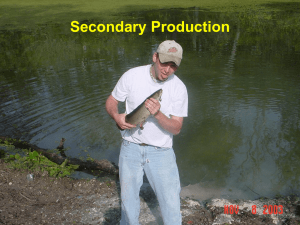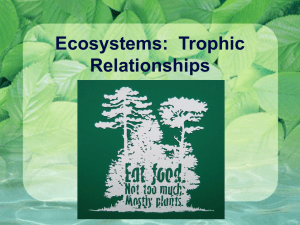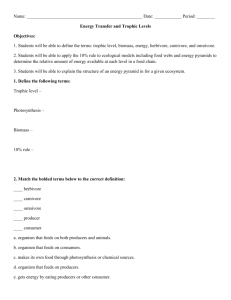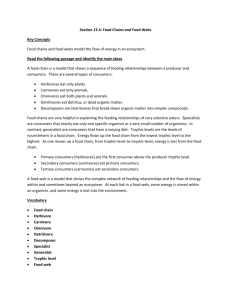Community Ecology I. Introduction A. Definitions of Community 1
advertisement
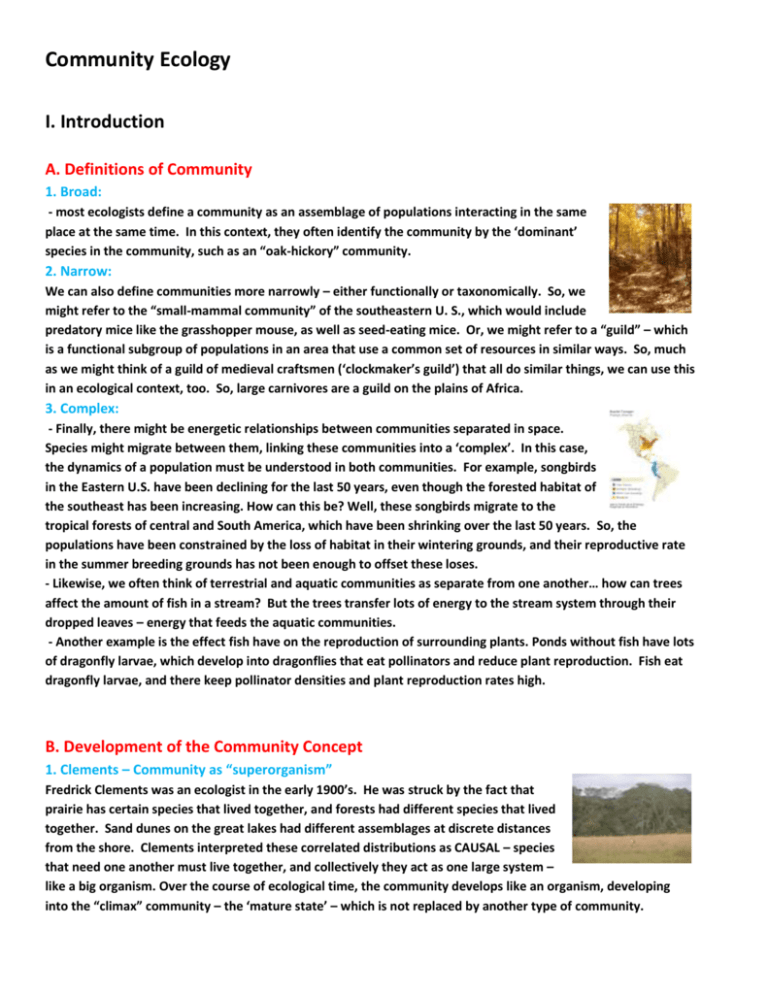
Community Ecology I. Introduction A. Definitions of Community 1. Broad: - most ecologists define a community as an assemblage of populations interacting in the same place at the same time. In this context, they often identify the community by the ‘dominant’ species in the community, such as an “oak-hickory” community. 2. Narrow: We can also define communities more narrowly – either functionally or taxonomically. So, we might refer to the “small-mammal community” of the southeastern U. S., which would include predatory mice like the grasshopper mouse, as well as seed-eating mice. Or, we might refer to a “guild” – which is a functional subgroup of populations in an area that use a common set of resources in similar ways. So, much as we might think of a guild of medieval craftsmen (‘clockmaker’s guild’) that all do similar things, we can use this in an ecological context, too. So, large carnivores are a guild on the plains of Africa. 3. Complex: - Finally, there might be energetic relationships between communities separated in space. Species might migrate between them, linking these communities into a ‘complex’. In this case, the dynamics of a population must be understood in both communities. For example, songbirds in the Eastern U.S. have been declining for the last 50 years, even though the forested habitat of the southeast has been increasing. How can this be? Well, these songbirds migrate to the tropical forests of central and South America, which have been shrinking over the last 50 years. So, the populations have been constrained by the loss of habitat in their wintering grounds, and their reproductive rate in the summer breeding grounds has not been enough to offset these loses. - Likewise, we often think of terrestrial and aquatic communities as separate from one another… how can trees affect the amount of fish in a stream? But the trees transfer lots of energy to the stream system through their dropped leaves – energy that feeds the aquatic communities. - Another example is the effect fish have on the reproduction of surrounding plants. Ponds without fish have lots of dragonfly larvae, which develop into dragonflies that eat pollinators and reduce plant reproduction. Fish eat dragonfly larvae, and there keep pollinator densities and plant reproduction rates high. B. Development of the Community Concept 1. Clements – Community as “superorganism” Fredrick Clements was an ecologist in the early 1900’s. He was struck by the fact that prairie has certain species that lived together, and forests had different species that lived together. Sand dunes on the great lakes had different assemblages at discrete distances from the shore. Clements interpreted these correlated distributions as CAUSAL – species that need one another must live together, and collectively they act as one large system – like a big organism. Over the course of ecological time, the community develops like an organism, developing into the “climax” community – the ‘mature state’ – which is not replaced by another type of community. 2. Gleason – the ‘individualistic’ concept of community Henry Gleason lived in the eastern deciduous forest, and recognized that although some species are found together, they aren’t LAWAYS found together. Species have overlapping distributions, but these distributions are largely independent of one another, dependent on the responses of each species to its environment. 3. Whittaker – Gradient Analyses Whittaker resolved this dilemma by appreciating that there were different types of communities; some which were composed of a specific set of species (closed), and others that had a large degree of overlap in species composition (open). He realized that the ‘abruptness’ with which communities would change over space might depend on the abruptness that the environment changed. Where the environment changed abruptly, communities would change abruptly and would appear closed. Where there were gradual changes to the environment, communities would change gradually. The place where environments changed abruptly, and where discrete communities met, is called the ecotone. 4. Pickett and White – Patch-Dynamic Theory The environment is not the only determinant of community type; the history of the site must be considered, as well. In reality, even in a very large expanse of habitat, there will be a series of patches of different successional ages, representing communities that are recovering from a disturbance at some time in the past. So, the community is a dynamic mosaic of successional patches of different ages, and variation in community type need not indicate differences in environmental conditions, but rather differences in the frequency of disturbance or time since the last disturbance. C. Key Descriptors 1. Species Richness - this is simply the number of species in the community 2. Species Diversity - species diversity includes some reference to the relative abundance of the species in the community. If all species are equally abundant, the community is very diverse. If there are species that are very abundant and others that are very very rare, then we would experience a less diverse community. Several indices measure diversity and are affected by changes in both richness and relative abundance (evenness). 3. Membership - this is perhaps the most fundamental descriptor, but it is often overlooked because it is not quantitative. This refers to WHICH species are present – not the number of species or their relative abundance. Two communities could have the same richness and diversity, but contain completely different species. 4. Trophic Relationships - This describes who eats who, and so describes the community in a FUNCTIONAL context. First, one must define the “nodes” or “interactors”. Typically, these are species. However, it may be that a group of species are ecologically similar and can be ‘lumped’ into one ‘trophic species’. Or, life history stages may be so different (like aquatic dragonfly larvae and adult flying dragonflies that prey upon and eat very different things) that one taxonomic species is divided into two or more trophic species. - Once the trophic relationships are described in a community, a number of attributes can be computed. On is “connectance”. Connectance describes the fraction of possible links that are observed in the community. The number of possible links = (S(S-1))/2. 1 2 3 4 So, with 4 species, the maximum 3 of 1 x x x Links = 4(4-1)/2 = 6…. Shown to the right. 2 x x If there were only 4 links, then the “connectance” 3 X C = 0.66 4 D. Conceptual Models of Trophic Relationships 1. Elton – Trophic Pyramids - In the 1920’s Charles Elton appreciated that organisms are involved in trophic relationships, forming “food chains” of producers, herbivores, and carnivores. He recognized that there were often rather consistent quantitative relationships among these levels, both ‘numerical’ (more plants than herbivores than carnivores), and in terms of biomass. He appreciated that there could be inversions in these relationships (lots of insects on one tree, or a small amount of insect biomass feeding lots of birds if the insects reproduced fast enough), but that PRODUCTIVITY… NEW BIOMASS PRODUCED / AREA / TIME COULD NOT BE INVERTED. 2. Lindeman – The Energetic Perspective Ray Lindeman, working in the 40’s, explained these consistencies energetically, in terms of energy flowing from one level to another through trophic relationships. Critical to his understanding was an appreciation for the metabolic efficiency of the animals in the web and how that would influence the structure of the pyramid and food web. A community dominated by endotherms, like mammals, would necessarily be short (usually 3-4 links in a ‘chain’); endotherms are very inefficient metabolically, converting only about 10% of the energy they consume into biomass. This is CRITICAL, because it is ONLY the energy converted into biomass that is available to higher trophic levels. If a lion eats me, he only gets the energy stored as chemical bond energy in my molecules; he doesn’t get the energy I spend to keep my body temperature high, or the energy I spent running away from him. Food webs dominated by ectotherms – like marine food chains – can be much longer (7 links in a chain) because they are 50% efficient, transferring more of they energy they consume into biomass, meaning that more levels can be supported before there is too little energy at the top to support another level. - The implication here is that the amount of herbivore biomass is influenced by the amount of food available; increase the amount of primary production and there will be an increase in herbivores and then an increase in carnivores. This describes “bottom-up” regulation of community structure. 3. Hairston, Slobodkin, and Smith (HSS) – “The World is Green” In the 1960’s, these three ecologists developed a different conceptual model, based on the observation that there was a super-abundant supply of plant matter in the environment. Shouldn’t the herbivores be increasing as they consume these resources? Why weren’t they? HSS reasoned that the herbivores must NOT be limited by food… they must be limited by carnivores. So, carnivores increase and become limited by their food supply. As such, they are limited by COMPETITION for limiting resources. Because they are gobbling up herbivores, herbivore populations do not grow to their carrying capacity; they are limited by PREDATION and are kept at low densities. As a consequence of low herbivore biomass, plants are released from predation and grow until they are limited by COMPETITION for nutrients. So, competition and predation alternate as the primary determinants as you move down a food pyramid. In this model, the community is regulated from the “top-down”, and effects ‘cascade’ down the trophic pyramid, with competition and predations alternating as we go. E. Empirical Tests of These Models 1. Leibold et al. (1997) - They looked at the biomass of producers (phytoplankton) and herbivores (zooplankton) across more than 50 lakes. As phytoplankton biomass rose, zooplankton biomass rose, demonstrating bottom-up effects. Many of those lakes were later stocked with fish. This caused a reduction in zooplankton, and an INCREASE in phytoplankton released from herbivory – a top-down effect. 2. Hansson et al. (1998) - They constructed “mesocosms” (intermediately sized communities) with 3 trophic levels or four levels. On average, adding the fourth level (fish) depressed zooplankton and released phytoplankton, as above. Adding more nutrients to each system caused similar effects that were demonstrated at different levels. So, adding nutrients in the three-level system pumped nutrients to the top level there – the zooplankton – with no real increase in producers. However, in the 4-level system, energy was pumped all the way up to fish. So, although zooplankton increased a little bit, they were limited by more predators… allowing producers to explode with more nutrients. Now, it is important to appreciate that ENERGY is still moving through zooplankton – they are reproducing more than they did at low nutrient levels… but this excess is gobbled up bypredators, leading their population to increase. The zooplankton population can’t increase, even though they are reproducing more, because that extra biomass produced in offspring is being transferred to predator biomass through predation. Study Questions: 1) Contrast the Clements and Gleason models of community organization, and explain how Whittaker’s model resolved this dilemma. 2) What additional element is included in Pickett and White’s “patch-dynamic” model, besides environmental gradients? 3) What is a guild? 4) How does species richness differ from a diversity index? 5) How do you calculate connectance? 6) Why are food webs with endotherms shorter (fewer levels) than those with ectotherms? 7) How should increasing primary productivity affect biomass in higher levels if bottom-up forces dominate? How about in a three-level community where top-down forces dominate?




